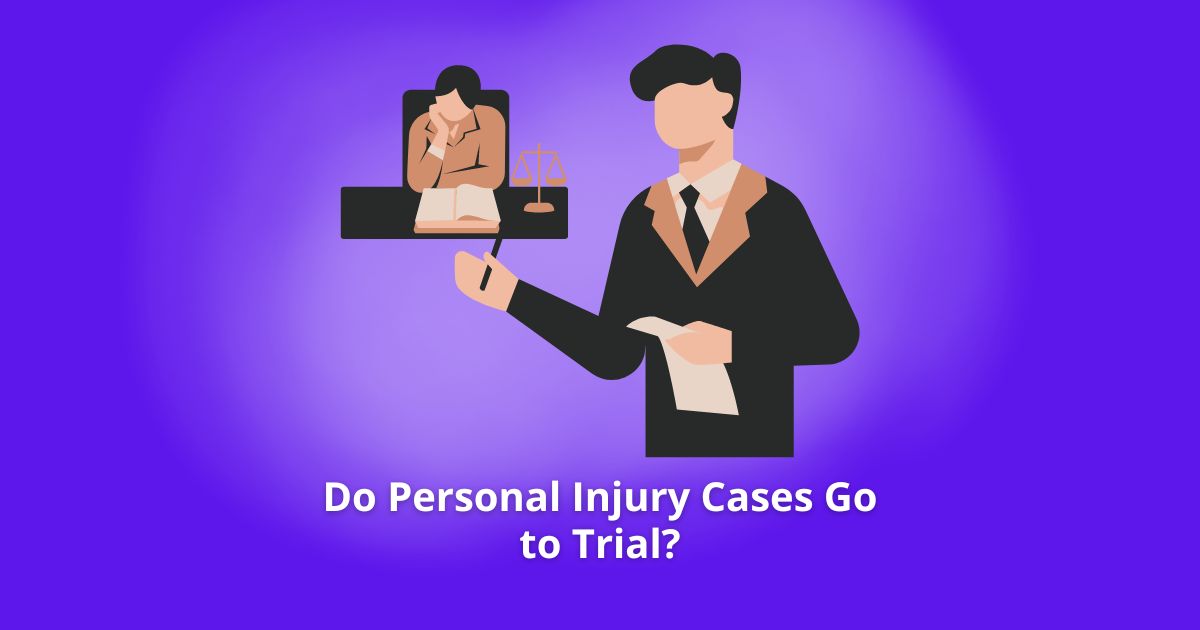Disclaimer:
The information provided in this article is for general informational purposes only and is not intended to be legal advice. While we strive to ensure the accuracy of the information, laws and regulations are subject to change and may vary by jurisdiction. Consult a qualified attorney or legal professional for advice regarding your specific legal situation. The author and publisher of this article are not liable for any actions taken based on the information provided herein.
Most personal injury cases are settled before reaching trial. This means that both parties often come to an agreement through negotiation or mediation. Such outcomes save time, legal fees, and the emotional stress associated with a court trial.

While settlements are common, some personal injury cases indeed go to trial. These instances usually involve disputes over facts, liability, or settlement amounts that cannot be resolved through standard negotiations. When a case does go to trial, it is decided by a judge or jury, who examines the evidence and makes rulings on compensation.
Each personal injury case is unique, and whether it goes to trial depends on various factors, including the strength of the evidence and the willingness of both parties to settle. Understanding these dynamics helps individuals manage their expectations and make informed decisions during the legal process.
Understanding Personal Injury Cases
Personal injury cases encompass a wide range of scenarios where someone is legally responsible for causing harm to another. The journey of a personal injury case often involves several stages that can vary significantly depending on the specifics of the situation.
➜ Definitions and Types of Personal Injury Cases
Personal injury cases generally involve harm caused by one party to another due to negligence or intentional acts. Common types include car accidents, medical malpractice, slip and fall incidents, and product liability.
Each type holds its own set of legal criteria and procedures. For example, medical malpractice requires proof of a healthcare professional’s failure to meet standard care. In contrast, car accidents typically focus on traffic laws and driver negligence.
➜ The Personal Injury Case Process
The personal injury case process starts with a complaint filed by the injured party. Key steps include investigation, discovery, negotiations, and potentially a trial.
During the investigation, both parties gather evidence to support their case. Discovery involves exchanging this evidence, while negotiations aim to settle without a trial. If necessary, the case proceeds to trial, where a judge or jury decides the outcome.
➜ Statistics on Case Resolutions
Most personal injury cases are settled out of court. It is estimated that 95% to 96% of these cases reach a settlement before they go to trial. This high settlement rate is attributed to the lengthy and costly nature of trials.
Insurance companies often prefer settlements to avoid the uncertainty of a jury verdict. Hence, many cases are resolved through negotiations, emphasizing the importance of strong evidence and legal representation.
Trials in Personal Injury Cases
Personal injury trials involve multiple factors, detailed procedures, and various possible outcomes. Understanding the specifics of these elements aids in preparing for what might unfold in the courtroom.
➜ Factors Influencing a Personal Injury Case Going to Trial
Several factors determine if a personal injury case goes to trial. Key aspects include the complexity of the case, the willingness of parties to settle, and the strength of the evidence. When both sides have significantly differing views on the compensation, trial becomes more likely.
Insurance companies’ strategies also play a role. They may opt for trial if they believe the claimant’s demands are unreasonable or the evidence supports their defense. Legal advice influences this decision, as some attorneys may recommend trial based on their client’s best interests.
➜ Trial Procedures and Participant Roles
The trial process for personal injury cases involves several steps. Pre-trial motions, jury selection, opening statements, evidence presentation, and closing arguments form the core phases. Each part plays a critical role in determining the case outcome and ensuring justice.
Participants include the plaintiff, the defendant, their respective legal teams, and the judge. Witnesses and expert testimonies often provide essential insights into the case. The jury, if present, deliberates based on the evidence and arguments, and finally delivers a verdict.
➜ Outcomes and Aftermath of Personal Injury Trials
The outcomes of personal injury trials can vary. The jury or judge may award damages to the plaintiff, reject the claim, or find partial fault in both parties. Compensation usually covers medical expenses, lost wages, and pain and suffering.
Post-trial, either party can appeal the decision, prolonging the case. Successful plaintiffs receive the awarded amount, though collection might take time if the defendant contests. Additionally, trial outcomes can influence future settlement practices and legal strategies in similar cases.